Queenslanders behind our renewable energy transformation
Queensland’s renewable energy transformation is taking advantage of our abundant renewable energy sources, like sun and wind.
This switch to renewables is also protecting and creating jobs across Queensland. Behind our state’s energy transformation are real people with real stories. Read how they and their communities are already benefiting from renewable energy.

Sugarcane farmer turning leftover pulp into sustainable fuel
North Queensland farmer Russell Hall is a staunch believer in the power of agriculture to propel our state to a net zero future.
That’s why he’s active in his support for a circular bioeconomy. For the President of AgForce Cane and longtime sugarcane farmer, this sees Russell turn leftover sugarcane pulp into renewable biofuels.
'Every small town and city in North Queensland has an abundance of agriculture at the forefront of their economy,’ Russell says from his farm in Clare, just south of Townsville.
‘With government support we could turn North Queensland into a powerhouse of clean energy, running 24 hours a day, 7 days a week.’
The region has long been regarded for its agricultural prowess. Currently, it represents approximately 95% of Australia’s 30-million-tonne sugarcane crop.
Queensland is working to seize this potential.
Already sugarcane waste, wood offcuts, used cooking oil, beef tallow and algae is recycled into bioethanol, biodiesel, renewable diesel and even sustainable aviation fuel here.
The trick to the transition, Russell says, is ensuring the agricultural industry adapts and remains competitive in an environment of climate variability, pests, disease and rising production costs.
‘Diversifying sugarcane processing away from solely crystal sugar production spreads the financial risk for growers and industry.
‘It also offers the potential for greater industry income, while accelerating the uptake of the Zero Emissions Vehicle Strategy.’
Find out more about the different types of renewables.
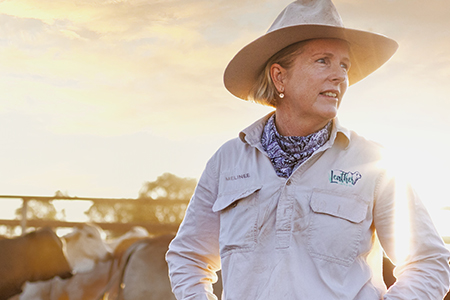
Farming and renewable energy coexist
In the heart of Central Queensland, colloquially known as Australia’s beef capital, the Leather Cattle Company is writing a new chapter in the story of Australian agriculture.
Melinee Leather, her husband Rob and the pair’s family have become beacons of sustainable agriculture, running 5,000 head of cattle while nurturing the health of the land and climate.
‘For us sustainability is about taking care of our people, animals, environment and our business,’ says Melinee, who has worked for Leather Cattle Company for nearly 4 decades.
‘Our family business has a deep sense of responsibility for how we contribute to global food security and climate action.’
In Central Queensland, where agriculture underpins the economic and cultural backdrop of the region, the challenges of climate change are ever present.
Yet Melinee and her family view this challenge as an opportunity to evolve, innovate and lead by example.
At their Barfield Station, plans are underway to reduce emissions by enhancing soil carbon storage.
The family is also a big advocate of agrivoltaics—co-locating solar equipment and farmland.
Melinee envisions a future where renewable energy not only powers farms but also opens new avenues for income and innovation, without putting food security at risk.
‘Queensland is the home to the largest herd in Australia. Any renewable energy developments must co-exist with agriculture production,’ she says.
‘Opportunity for diverse income and reversing the impact of climate change will benefit the long-term viability of beef farming.’
For Queensland farmers considering this path, please visit the Queensland Renewable Energy Landholder Toolkit.

Renewable energy projects creating jobs for local workers
Steve is a proud Kingaroy local and, like many Queenslanders, he is passionate about shaping the future of energy in our state.
Renewable energy is a huge part of Queensland’s future, but for Steve, his story goes right back to 1987 when he joined public energy provider Stanwell as a young apprentice.
More than 30 years later, this energy sector journeyman transitioned his decades of experience to the Wambo Wind Farm, located near Jandowae in the Darling Downs South West region.
Steve’s role is just 1 of 200 jobs created throughout the construction of this project.
The renewable energy transformation represented a fascinating new learning opportunity for Steve. It also offered benefits for his family, the local economy and his community.
'There’s significant input to the local economy through local contractor and service provider engagement such as accommodation, food and beverage,’ Steve says, referring to the real-world benefits of a project like Wambo.
‘It also means a future for my family, an opportunity for our children, and something to marvel at and learn from.’
With the project being close to home, Steve enjoys nothing more than having a ‘yarn’ to people about his work. He says people have plenty of interest and many questions.
'How much diesel are you burning to build that?’ and ‘Have you got a generator powering your compound?’ are the 2 most common questions.
‘Then there are others like how big the towers are, how long do they take to build, will they last 30 years. Generally people are interested in the process and opportunities.’ he says.
The Wambo Wind Farm is being constructed as a joint venture between Stanwell and Cubico Sustainable Investments. Stage 1 delivery for the Wambo Wind Farm will generate 252MW of clean energy and power the equivalent of up to 170,000 homes every year upon completion in 2025.
Learn more about wind energy and how we generate electricity in Queensland.
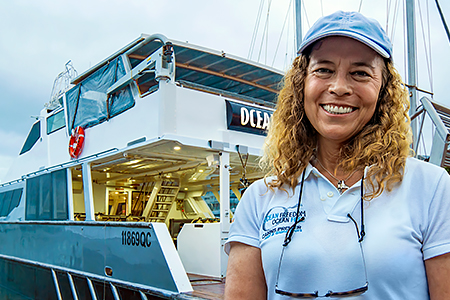
Cairns-based tourism powering towards clean energy
After completing her Masters in Physiotherapy, Malta-born Taryn Agius arrived in Cairns in 1992 for what she thought would be a short stay. Then she fell in love with the Great Barrier Reef.
Taryn met her British husband Perry, who was already in the diving Industry, in Cairns in 1992. In 1996, the duo founded their own company Cairns Premier Great Barrier Reef and Island Tours. For almost 30 years now, they have specialised in low number, guest-orientated full day Great Barrier Reef tours departing from Cairns.
Taryn and Perry’s combined love of the ocean means care for the environment is always at the heart of their operations. Their fleet includes a 16m sailing vessel named “Ocean Free” with minimal carbon footprint, and a fast 20m catamaran named “Ocean Freedom”.
Since 2019, the pair have focused on research and development and finding a clean energy solution for chartering boats to the Great Barrier Reef.
This 4-year journey led them to plan for their third vessel, a 24m electric-hybrid eco catamaran. Despite several hurdles (due to the application of new technology in a commercial arena) Taryn and Perry’s dedication remains un-waivered, with the build to start soon and the launch date set for June 2025.
‘As part of our ongoing journey to protect the environment and the Great Barrier Reef, we have been looking at alternatives to diesel power for many years,’ Taryn says.
‘You can forever wait for the next best thing, but we strongly felt that the next chapter in our sustainable and responsible tourism journey had to be a “greener” vessel.’
Cairns Premier Reef and Island Tours is recognised by the Great Barrier Reef Marine Park Authority as a High Standard Tourism Operator and a Green Travel Leader by Ecotourism Australia due to their longstanding Advanced Eco Tourism accreditation.
‘Tourists are chasing responsible and sustainable tourism, but that has always been at the heart of our operations, and we are committed to continuing this journey forward with our new cleaner energy next generation Great Barrier Reef vessel.
We come from a very eco-aware region, and this project further promotes our region as being serious in our quest for continued and enhanced sustainable and responsible tourism.’
This sentiment is echoed by fellow operators in Far North Queensland, who acknowledge the value of two neighbouring UNESCO World Heritage areas, and a need to protect them.
‘Our mission is to deeply connect our guests to the reef,’ she says.
‘We believe in positive experiences for positive change. If someone loves something, then they will want to protect it.’
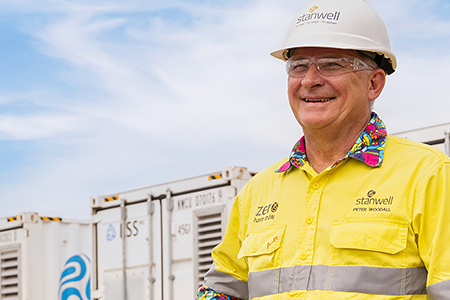
Next generation of energy workers
Peter Woodall is an electricity industry veteran.
He began his career as an apprentice at the Tarong Power Station over 30 years ago. Since then, Peter’s journey has seen him transition his skillset across to the renewable energy sector. A move he’s glad he made.
So passionate about the potential of this growing industry, Peter is now the Future Pathways Manager for public energy provider Stanwell. Here he helps prepare the next generation of Queenslanders for the transition to a renewable future.
'Weʼre creating development pathways and early career programs for existing tradespeople, trainees, apprentices and graduates,’ Peter says.
Also of interest to Peter and his team are the technical abilities of electrical, mechanical and chemical workers. These trade and engineering qualifications transfer nicely into wind, solar and hydrogen industries.
'The skilled workforce from the existing fossil fuel power stations prepares workers for an almost direct transition into renewables.’
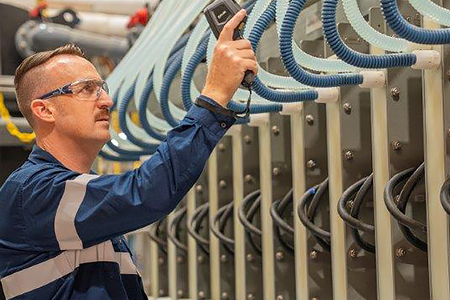
Local talent leading the transformation
The opportunity to transition from traditional heavy industry to renewable battery manufacturing was a leap Nigel is happy he took. It’s also one Nigel was able to do from his home base in Townsville.
After 15 years of building his career in base metal refining, Nigel transferred his skillset to take on the role as Plant Manager at Vecco Group for Australia’s first vanadium electrolyte manufacturing facility.
‘It’s a Queensland company, based in Queensland, delivering a product for Queenslanders,’ says Nigel.
The vanadium batteries Nigel and his team are helping to manufacture will shortly be storing renewably sourced energy for use by Queenslanders, around the clock.
Coming from base metal refining, Nigel says he’s enjoyed the change in process.
‘The type of work here is clean and automated, and you can transfer your knowledge to a future industry,’ he says.
‘We’re pioneering vanadium electrolyte manufacturing. That’s why I wanted to help build Vecco’s operations from scratch and be on the ground floor for the growth of a new industry.’
Helping build any new industry is no small feat, yet Nigel says his job is made easier by the strength of talent on offer in North Queensland.
‘The reason it works is because it can be done locally, and we choose to engage local trades and suppliers.’
Construction of the facility took only 4 months, with many contracts awarded to local builders and suppliers. This ‘look-local’ ethos is one Vecco carries through to its everyday operations.
‘Townsville has a large pool of the right skillsets. We’re also working with the local TAFE to develop the advanced manufacturing training so young people have opportunities.’
Even though the vanadium battery supply chain is still ramping up, Nigel says the benefits Vecco has provided to the Townsville community are obvious.
‘We’re helping workers and the state transition to a cleaner future.’
Learn more about the role of batteries in our renewable energy mix.
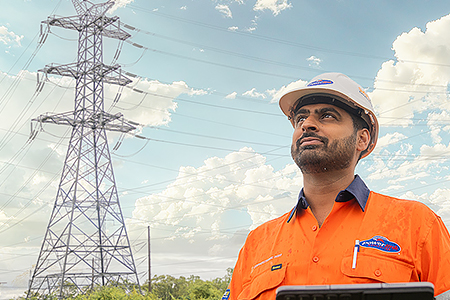
Working alongside regional communities
Motivation for Powerlink Construction Director Vikram Dhiman is as strong as ever after 18 years of service for the government-owned power company.
For Vikram, helping progress an evolving energy landscape is a rewarding assignment.
‘Working as part of a team that is responsible for delivering something meaningful and beneficial for future generations really motivates me,’ Vikram says.
‘The satisfaction that I’ve gotten over the years from being part of major projects, tight knit project teams and the relationships I’ve built with customers and communities, are really valuable to me.’
Vikram is seeing the community benefits of these large transformational projects firsthand. He’s currently working on the $5 billion Powerlink CopperString project, a 840km new electricity transmission line running from south of Townsville in the Burdekin region to Mount Isa.
‘Weʼre building an electrical superhighway for North Queensland. It's going to help local industry unlock more than $500 billion of critical minerals and turn our region into the nation's largest renewable energy zone,’ he says.
Vikram started at Powerlink in 2006 as a Development Engineering Officer, while learning his craft and completing his engineering studies.
Since, he has worked his way up to Project Construction Director. He's also travelled the state, working in Townsville, Rockhampton, Chinchilla, Roma and Warwick.
‘I’ve really enjoyed living and working in these communities and have developed some great relationships by working towards mutual benefits for the community and the project,’ Vikram says.
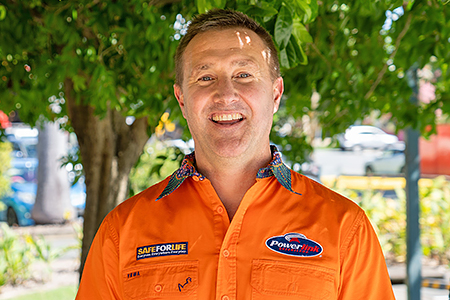
Upgrading our energy infrastructure
For Powerlink Project Director Tony Janas, his passion for the Genex Kidston Connection Hub is rivalled only by his steadfast love for the Parramatta Eels.
Despite this questionable choice of a non-Queensland team, there’s no question about Tony’s passion for Queensland's renewable energy future.
This enthusiasm is articulated when Tony talks about the importance of the Genex Kidston Connection Hub project. He tells a story of innovation, future benefits and positive community impact.
For Tony, the Genex Kidston Connection Hub is more than just a project.
'This is more than building transmission lines to connect renewable projects to the national electricity grid,’ Tony says.
'The energy transformation in northern Queensland offers a pathway towards a more sustainable, resilient and prosperous future for the environment, local communities and economies.’
About 186km of 275kV high voltage transmission lines are being installed to connect the Kidston Clean Energy Hub, located approximately 270km northwest of Townsville into the national electricity grid.
Across the lifespan of the project, more than 25 local suppliers will be engaged and $30 million awarded in local contracts.
'Not only will this project give Queenslanders access to stable and reliable power, but it is already boosting local economies and supporting more than 400 individual jobs,’ he says.
Working from both Townsville and Brisbane has also given Tony great insight into the benefits of the different regions working together.
He believes it is very encouraging when visiting remote areas of Queensland to see the great work that Powerlink is doing in connecting these communities to a world-class energy future.
'We’re aiming to push the boundaries of innovation, engage with local suppliers and boost regional economies so we all reap the benefits from the energy transformation.
This plan sets out a 15-year journey for Powerlink – and we are just getting started.’
Sitting more closely to the Cowboy’s Queensland Country Bank Stadium than Parramatta’s Commbank Stadium, Genex Kidston Connection Hub is an important project in Queensland’s energy future.
It’s here and across the state that Tony and his colleagues at Powerlink are working with local communities to shape a future supported by world-class renewable energy.
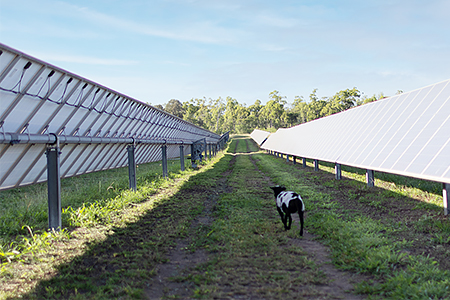
Grazing sheep among a 70MW solar farm
A blue sea of solar panels sits atop a Mackay Isaac Whitsunday landscape, close to Collinsville. It’s here that 830 sheep can be found, grazing happily between the rows of panels.
This is Hamilton Solar Farm where partners Edify and Gentari are working with the landowner to find sustainable collaborations between agriculture and renewable energy.
For generations, the land surrounding the farm has been known for its cattle grazing. However, the threat of dingos has previously deterred sheep farmers.
Now, the security of Hamilton Solar Farm is providing a haven for the sheep. The flock has even welcomed lambs since they took up residence in November 2023.
Isaac Fernandez, an Asset Manager at Edify, says this collaborative spirit is helping to create a smooth transition to renewable energy for all Queenslanders.
‘The sheep on Hamilton is just one example of how renewable projects can work collaboratively with community and partners,’ Isaac says.
‘The solar farms in this beautiful part of the world have given a boost to the local economy and put Collinsville on the map as part of Australia’s energy transformation.’
During construction of Hamilton Solar Farm, 247 jobs were created. Today, a team of 5 work onsite to ensure the smooth operation and maintenance of the farm, which has capacity to power roughly 31,000 Queensland homes.
‘It feels good to be part of the ecosystem of benefits that renewable energy brings to people and mother earth,’ Isaac says.
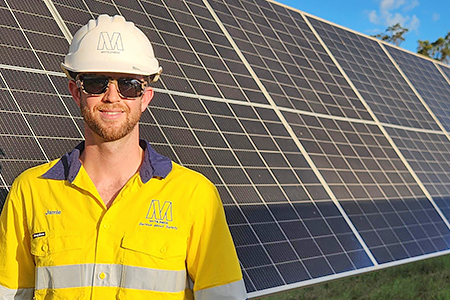
Building best practice solar farms
Helping build solar farms has taken Jamie Lyon across the country.
His work as a quality assurance and quality control engineer has seen him involved in projects from Wyalong in New South Wales to Kingaroy and Munna Creek in Queensland.
‘I have now completed 7 projects and gained a wealth of experience and memories from across Australia,’ he says.
‘It has been a great way to work and travel while also promoting a more sustainable future for Queensland.’
Most recently Jamie has been working on the Moura Solar Farm, located 6.5km southwest of Banana and 12km east of Moura in Central Queensland.
The project is operated by Greece-based multinational energy and metals company Mytilineos Energy & Metals. It is active in more than 40 countries and since 2019 has invested $500 million in Australian renewable energy projects, particularly in Queensland and New South Wales.
The site in the Banana Shire was selected due to its abounding sunshine, proximity to Powerlink’s transmission network and easy access to the Dawson Highway.
‘I have seen a lot of benefits to the local communities,’ Jamie says. ‘There’s been an influx of new faces and investment in the surrounding area.’
Approximately 185,776 solar panels at the Moura farm are producing enough clean energy to help power more than 43,000 Queensland homes. Technical tracker systems see the panels slowly turn to follow the sun throughout the day, maximising the farm’s output.
Additional measures help minimise the impact to the land. The panels are piled or screwed into the ground to avoid the use of concrete foundations.
‘I had no previous experience in construction prior to my first solar farm,’ Jamie says. Now he’s at the forefront of solar technology globally, constructing best practice projects that safeguard natural assets and produce green energy.
Weekly, monthly and 6-monthly inspections and tests are carried out by the team to monitor the health of the site and manage the mechanical and electrical infrastructure.
This continued management of the project has meant ongoing jobs for local workers, an example of how the energy transformation is creating opportunities for people in the regions.
‘The renewable sector is booming and it’s creating an array of jobs for people with all types of experience and backgrounds, with or without formal qualifications.’
- Last updated
- 27 May 2025